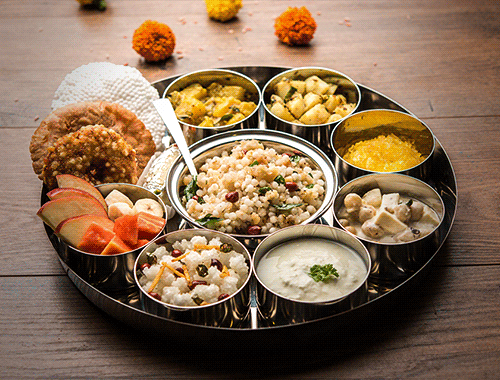Navratri is almost here, and it’s time to decorate your homes for Her to shower blessings in abundance! While there are many ways to celebrate these nine days, the most widely observed custom in India is the Navratri fast!
Navratri Upvas recipes are designed to satiate those hunger pangs and leave you feeling full for longer. This will enable you to perform the pooja for the Goddess and will keep you hydrated and energetic throughout the day! You can find various Navratri Upvas recipes in Maharashtrian Upvas cuisine. From Upvas Thalipeeth to Sabudana Wada, satiate your hunger with these energy-boosting fasting recipes.
Another exciting thing during the Navratri fast is you can use these recipes as prasad, too, since all of these are mild in flavour!
What food can be Eaten during Navratri Fast, Vrat or Upvas?
Navratri fasting food includes a mix of fruits, dairy, nuts and seeds, flavoured with various spices. Some popular dishes are Sabudana, Sama Chawal, Millet Uttapam, Vrat Thalipeeth, Upvas Bhajani & Suhana Upvas Bhajani, among others.
-
Sabudana (Sabakki) :
Made with sago pearls, potatoes, and spices. It’s rich in carbohydrates and can fuel you through the day.
-
Sama Chawal (Bhagar) Pulao:
A dish made with sama rice, veggies, and spices. It’s satiating and delicious.
-
Vrat Thalipeeth :
This savoury fasting pancake is cooked with wheat flour and spices and is a tea-time snack.
-
Upvas Bhajani :
It’s a vegetable and spiced stir-fry dish that has a sweet and sour taste.
-
Kuttu Dosa :
A pancake prepared with buckwheat flour and spices.
-
Rajgira Roti :
Tastes like regular roti but is made of amaranth flour. You can enhance the flavour by adding masalas like you add for regular parathas.
-
Kuttu ka Paratha :
This is made from buckwheat flour and mashed potatoes with a hint of hing and green chillies for the flavour.
Which Navratri Upvas/Fasting Meals can one eat during Breakfast and Lunch?
There are many delicious and nutritious Navratri fasting meal options for breakfast and lunch. For breakfast, take your pick from a Sabudana Idli, Suhana Ready-To-Eat Poha Mix, to Green Sabudana Khichdi for breakfast or lunch. Read on to know more.
-
Dahi Aloo:
For breakfast or lunch, yoghurt and spicy potatoes are frequently eaten with paratha or roti.
-
Sabudana Idli:
Sago pearls, potatoes, and spices are used to make steamed cakes. During fasts, it is a popular dish for breakfast or lunch.
-
Tarri Batata Poha:
A mixture of spices, potatoes, and flattened rice that has been tempered with mustard seeds and curry leaves. Usually, people eat it for lunch or breakfast.
-
Suhana Ready-To-Eat Poha Mix:
Flattened rice, vegetables, and spices dish can be enjoyed quickly and simply. It can be had as a snack, breakfast, or lunch.
-
Green Sabudana Khichdi:
Made with sago pearls, potatoes, and green vegetables and simmered in a lentil broth with spices. It is a popular fasting breakfast option.
-
Sattvik Palak Paneer:
Spinach and paneer (cottage cheese) are served in a mildly spicy sauce. This popular vegetarian recipe is suitable for breakfast, lunch, or dinner.
-
Makhana Kheer:
This fasting dessert is prepared with milk, sugar, and roasted lotus seeds.
-
Upvas Dhokla:
Gram flour, yoghurt, and spices make this savoury snack that’s generally eaten for breakfast.
-
Singhare Poori:
This poori is made of chestnut flour with cumin powder, potato, green chillies and ginger.
What are Traditional Navratri Upvas Sweets or Desserts?
When fasting during Navratri, most people assume you would have to skip desserts. However, that’s only sometimes the case. Here are a few fasting desserts that you can indulge in.
-
Basundi:
This liquid dessert is made with milk and sugar and flavoured with cardamom.
-
Amrakhand:
Yoghurt, sugar and mangoes are generously used to make this sweet treat.
-
Malai Ladoo:
Made with milk solids, sugar and nuts, these decadent ladoos make for a delicious mouthful.
-
Mango Raita:
Mango, yoghurt, and spices blend to make this yummy, sweet treat.
-
Papaya Halwa:
Papaya, sugar, milk, spices, and nuts all come together in a yummy dessert that is hard to resist.
-
Rice kheer:
Rice, nuts, milk, and sugar make this Khir dessert irresistible.
-
Dry Fruit Kheer:
This sweet dish is made with dry fruits, sugar, milk and spices and is a sweet treat.
-
Nariyal (Coconut) Pag:
These square-shaped coconut bites are a yummy treat to look forward to, even on fasting days.
Looking to enhance the flavour of these sweet treats? Add Suhana Kesari Milk Masala and see everyone go in for second helpings.
What foods to avoid while fasting?
The Navratri fasting period is also a time to give your body some rest to detoxify while consuming light and nutritious meals. During fasting, people abstain from having non-vegetarian food, grains and cereals, alcohol and tobacco, salt, legumes, and lentils.
-
Non-Vegetarian Food :
As meat, fish, and eggs are forbidden on fasting days, many people abstain from consuming them during this time. Additionally, some people believe they are cleaning their minds, body, and spirit by abstaining from non-vegetarian food.
-
Grains and Cereals :
People avoid both to reduce their intake of carbohydrates and calories.
-
Alcohol and Tobacco :
Fasting is all about detoxification and cleansing. Hence most people tend to avoid consuming alcohol and tobacco as they are addictive.
-
Salt :
Most people, avoid salt to retain fluids and to avoid dehydration.
-
Legumes and Lentils:
They are rich sources of protein but can cause bloating and gas, so many people avoid them.
We hope you have noted the recipes and would also love making these during this Navratri.



